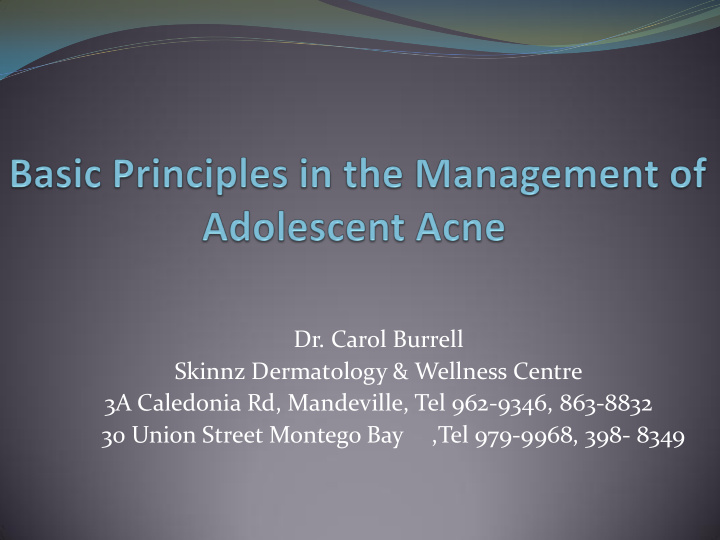



Dr. Carol Burrell Skinnz Dermatology & Wellness Centre 3A Caledonia Rd, Mandeville, Tel 962-9346, 863-8832 30 Union Street Montego Bay ,Tel 979-9968, 398- 8349
Acne: Definition Chronic inflammation of the pilosebaceous unit characterized by sebum retention. Appears during puberty in people with seborrhoeic skin. Predominantly on the face and to a lesser extent on the thorax, back, neck and shoulders (areas with the greatest number of sebaceous glands) With little or no relation to food Many types of lesions: papules, pustules, comedones, cysts, nodules, scars- depressed or hypertrophic
Acne Vulgaris Many types of lesions
Acne Vulgaris Many types of lesions
Acne Vulgaris Many types of lesions
Acne: Prevalence Affects adolescents – 12-17 yrs. 40% of adolescents suffer from severe acne requiring treatment. May disappear on its own. May persist into the 20- 30’s. Affects the sexes equally, but more severe in males, with earlier onset in females. Potential to leave scars.
Acne: Aetiology (multifactorial) 1. Increased Sebum Production: Sebaceous gland stimulation resulting in growth and greater sebum production Androgen dependent. 2. Poral Occlusion : skin pores clogged (sebaceous duct hyperkeratinisation). 3. Bacterial proliferation on the skin ( Propionibacterium acnes ). 4. Dermal Inflammation Immune response: Inflammation and erythema caused by inflammatory mediators. Genetics play an important role.
Acne: Treatment Combination therapy: 1. Increased Sebum Production: Anti-androgens, Retinoids 2. Poral Occlusion : Cleansing, Abrasive scrubs/cloths, Retinoids, comedone extraction, microdermabrasion 3. Bacterial proliferation on the skin: Antibiotics (Systemic and local ) 4. Dermal Inflammation: corticosteroids topical and intralesional into cysts
Current treatment options Topical Oral Retinoids: Tretinoin, Adapalene, Isotretinoin, Benzoyl peroxide, Antibiotics ( Tetracycline, Antibiotics (Clindamycin 1%, minocycline, doxycycline, Erithromycin 2%) erythromycin, TMP/SMZ) Azelaic acid Isotretinoin Salicylic acid Hormone therapy Combinations Corticosteroids (BP + antibiotic Ret + Antibiotic), Glycolic acid Others Facials Chemical peels Microdermabrasion Phototherapy Filling Materials Surgery
Acne: Treatment goals Reduce/eliminate comedones − Normalise/correct follicular keratinisation − Reduce glandular activity Reduce/eliminate inflammatory lesions − Reduce P. acnes (bacterial population) − Reduce inflammatory response Prevent sequelae − Minimise psychological effects − Minimise scars
Treatment – General Measures Wash twice daily with warm water and soap – sulphur soap, triclosan, antibacterial soaps, Scrubs – Two to Three times weekly Do not manipulate the lesions No special diets, maintain balanced diet, water , fruits and vegetables Avoid any dietary aggravating factors Keep hair clean
Treatment – Specific Measures Topical agents : BPO - 2.5%, 5% Clindamycin – 1%, 2% Erythromycin – 2% BPO/Clindamycin combination Retinoids – Tretinoin, Adapalene Retinoid/ Antibiotic combination Retinoid/BPO combination
Treatment – Specific Measures Systemic agents : Antibiotics – doxycycline, minocycline, azithromycin Isotretinoin – must monitor liver enzymes and cholesterol. Does not cause liver damage. Teratogenic Hormonal treatment – anti androgens – contraceptives, ciproterone acetate, spironolactone
Treatment – Specific Measures Comedone Extraction Intralesional corticosteroids Microdermabrasion Surgery – Scar excision, Subscision, Needling or Dermarolling Phototherapy
Summary Acne is a very common condition Acne may persist into adulthood in certain patients (especially females) Acne patients frequently experience physical as well as psychological problems Early treatment is very important to control the disease and prevent the physical and emotional sequelae.
Thank You
Recommend
More recommend